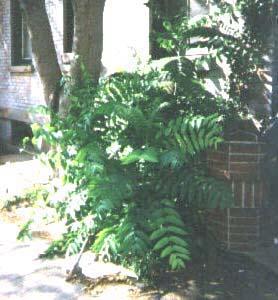Only in our crazy town can a type of rock be controversial. To most New Yorkers a "Brownstone" signifies a stately 19th Century rowhouse. The rich, chocolate brown stone adorns the fronts of thousands of Manhattan and Brooklyn homes, usually in areas originally populated by the then new urban middle class, as well as many university buildings, churches and other institutions. To others, however, brownstone was an affront to the eye, a symptom of pompous bourgeois bad taste and a nightmare to maintain. The author Edith Wharton called it the ugliest stone she had ever seen.
As we shall see, the history of the use of this stone says a great deal about our city. In the period prior to the 1830's or so, most of the rowhouses being constructed in New York had either brick or wood facades. Alternatives such as marble existed, of course, but these were far too costly for most homeowners to consider, especially since the stone had to be
cut by hand and transported long distances. With the growth of the new urban middle class came a desire for something more sophisticated in appearance than simple brick, and more durable than wood. Brownstone, a type of sandstone, was readily available from quarries located in New Jersey and Connecticut. A form of sedimentary rock which frequently contains fossilized footprints of prehistoric animals, it owed its unique dark brown color to high concentrations of iron, which turned color with exposure to water. Using barges, it could be shipped easily to New York, where it quickly became popular. In Brooklyn, brownstone houses could be found anywhere from Bedford Stuyvessant to Brooklyn Heights and Carroll Gardens.
Houses themselves were not constructed of brownstone, but rather a veneer less than a foot thick was placed on the front of each home, which was actually constructed of brick. The mark of a good brownstone mason was his ability to cut and assemble the blocks of a facade so carefully that it almost appeared to be a single mass of stone. Look for this the next time you are in a brownstone community. The development of steam-powered stone cutting equipment, as well as the continuing expansion of the middle class, eventually caused brownstone to lose some of its appeal as a status symbol. Indeed, many experts on the subject claim that the stone which was quarried and sold to New Yorkers after the Civil War was of significantly poorer quality. As the 19th
Century drew to a close new styles of architecture and other materials were coming into vogue. As a result, almost nothing new was being built using brownstone. Meanwhile, the very composition of the stone was causing headaches for those whose homes were made with it. Brownstone consists of many layers of compressed sediment, and water would easily find its way into the material, causing it to crack and flake.
When layers of brownstone chip away, the stone which remains is often of a substantially different color. This can create some interesting visual effects, but does not exactly create a dignified appearance. In an effort to repair such pock-marked surfaces, many brownstone owners have taken to using special colored cements - a practice which some historic preservationists are quick to condemn. As one can easily imagine, it is difficult to create a stucco compound with the same precise shading and texture of a block of stone quarried over 150 years ago.
The current boom in the renovation of old buildings has created a new market for brownstone, and some quarries in Connecticut are now back in business, although experts disagree over the quality of the material currently being cut. One of the recipients of this newly cut stone is the beautiful Cooper Union building.
Today, fans of brownstone architecture can delight in many stunning examples of the stone's usage, chiefly in Manhattan and the downtown areas of Brooklyn. To sample a good variety of the architectural styles with which the stone was used, I suggest a stroll from Cobble Hill, where the earlier Greek Revival homes dominate, through Boerum Hill and finally Park
Slope, which offers stunning examples of the Neo Grec, Italianate and Romanesque forms. Residents of Queens will be forced to settle for a few isolated houses near the Astoria waterfront. For an interesting example of a modern building constructed with brownstone, see the Bobst Library at New York University, on Washington Square South.
Sources:
Gerald Wolfe, NEW YORK, A GUIDE TO THE METROPOLIS.
Tracie Rozhon, "Brownstone (the Real Thing) Comes Back," NY TIMES, 7/4/2000, p1.

